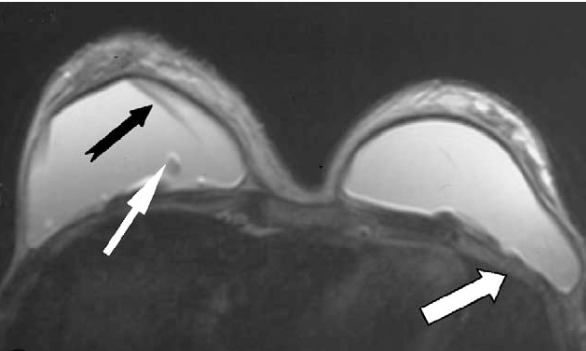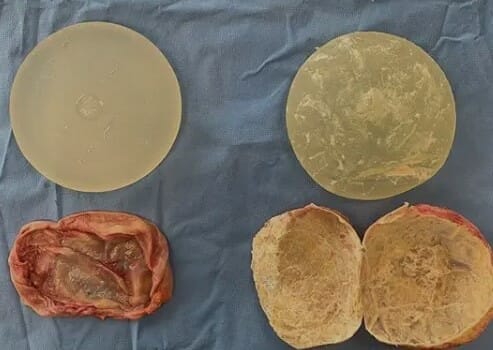Breast Implant Removal in Fort Lauderdale
Why Remove your breast Implants?
What is involved in removing breast implants?
Breasts implant removal can be a very simple procedure. In the more straightforward of cases, a small incision is made where the prior scar is located. The surgeon enters the implant cavity and removes the implant. However, in other situations the procedure can be more complex. This depends on the several factors affecting women after breast augmentation. The size of the implants is an important consideration. The larger the implants the more excess skin will be left after implant removal. These cases will require a mastopexy or breast lift. Implants can be ruptured or have suffered capsular contracture. In these cases a capsulectomy is be required. Following is a list of the more common procedures recommended for removal of implants.

Simple implant Removal
Implant Removal and Capsulectomy
If the implants are ruptured silicone gel implants, you should strongly consider a capsulectomy. If the implants are affected by capsular contracture, the same consideration applies. The capsule is a spherical shell of scar tissue. It forms over an implant after it is in the body for over 4-6 weeks. Capsular contracture is when this shell of scar tissue becomes thick and hard. The implants may become quite uncomfortable. Sometimes silicone gel extrudes from the implant shell and infiltrates the capsule forming a hard calcified shell. In either situation, removal of the implant, implant material and capsule is recommended.
When the entire capsule shell and implant is removed in one specimen, this is termed an en-bloc capsulectomy. An important benefit of an en-bloc capsulectomy is that it prevents the free silicone gel inside the capsule. This gel does not contaminate the breast implant cavity. This free silicone gel can be sometimes difficult to completely remove.
A partial capsulectomy, is most commonly performed. This involves removal of a portion of the capsule, usually the portion adhered to the breast skin flaps. The portion against the chest wall can adhere tightly to the chest wall periosteum and perichondrium. This makes it more difficult and traumatic to remove.
Implant Removal, Capsulectomy and Mastopexy
Implant Exchange, with or without a Mastopexy
Breast Implant Removal and Fat Grafting
Who is a Good Candidate for a Breast Implant Removal?
Preparing for your breast implant removal
Medications
Smoking
Mammogram and Ultrasound
Physical Exam
Dr. Thomassen will examine you to determine how best to undergo the surgery. Key information gathered in the exam includes your current breast cup and asymmetry. It also includes palpation of any axillary or breast masses. The presence of breast ptosis or excess breast droop is noted as well.
It may be possible to determine if you will suffer from excess breast ptosis before implant removal. In this situation, you are a likely candidate for a mastopexy. This can be more confidently assessed at the time of removal. For this reason, some patients choose to stage the mastopexy for a later date after the implant removal. This way, you can ensure you would benefit from this additional procedure.
Choosing the Breast Implants
Preoperative Clearance
Days before Surgery
- Avoid strenuous exercise in the days leading up to your surgery. You should be well rested leading up to your surgery date. Also avoid excessive sun exposure.
- Refrain from alcohol the week before surgery.
- Pick up your prescriptions with plenty of time before your procedure. Set up a comfortable recovery area at home. Plan your meals including a light clear liquid meal for the first night.
- Plan for someone to be with you for 24 hours after surgery.
- You will receive a call from our Operating Room Nurse a few days before your procedure. In this call, they will go over the consent. They will also discuss preoperative details and instructions to make sure you are ready for surgery.
- You will recieve a call from our Anesthesia Provider the day before surgery. They will to go over your medications and discuss details about your anesthesia.
- Use antibacterial soap when showering the day before surgery.
- Remove any piercings or jewelry you may have before coming in for the procedure.
What to expect the day of surgery
The day of your breast implant removal surgery you will arrive at our Fort Lauderdale office at the appointed time. Wear something loose and comfortable that you can easily remove and put back on after the procedure. A button down shirt and loose pajama bottoms are ideal.
You will meet the surgical team, including a preop nurse and anesthesia provider. Dr. Thomassen will answer any final questions you may have regarding the procedure and do some markings.
What Anesthesia is Used for a Breast Implant Removal Procedure?
How long does the breast implant removal procedure take?
What is the Recovery like for a breast implant removal
Your first follow up with Dr. Thomassen will be in 1-2 days after surgery. You will have small steri strips or tapes along your incisions. Dr. Thomassen will remove these on your second visit. Your breast size will be larger in the first few weeks due to swelling.
You should not undertake strenuous exercise for at least 4 weeks after surgery. Light walking is fine the first week and you can gradually increase exercises as you feel better.
You will be started on implant mobility excercises at 2-3 weeks after surgery. Implant mobility exercises are important for two reasons. First, they appear to be helpful in preventing capsular contracture. Second, as patients are able to stretch their tissues with the exercises, they are able to become comfortable more quickly.
See Results of Implant Removal and Mastopexy by Dr. Thomassen.







